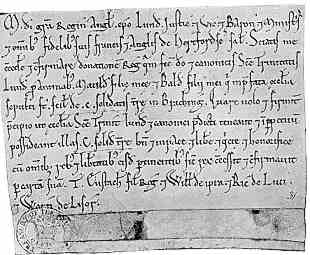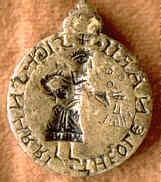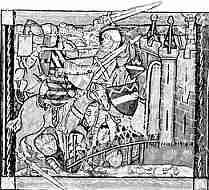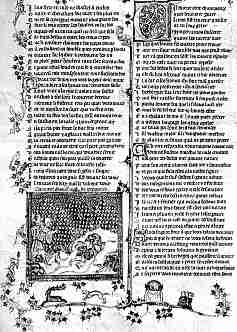



If you are looking at this page without frames, there is more information about medieval writing to be found by going to the home page (framed) or the site map (no frames).
| The Laity (3) | |||
| The 12th century was a significant time in the expansion of literacy and literate usage. There is evidence that the kings of England from Henry I onward were instructed in Latin. The desire to be litteratus extended to the aristocracy of the court in the reign of Henry II, as learned discussion on matters intellectual in the manner of the clerical schoolmen was evidently quite the done thing at court. | |||
| As literate processes in government and administration increased, there were ever increasing numbers of people whose job it was to be literate to some degree. Malcolm Parkes (Parkes 1991) refers to this as "pragmatic literacy" and the expression seems to have stuck in the scholarly literature. Charters, letters patent and writs were in Latin at this time, and a whole range of people from the chancery officials who drafted and wrote and copied them to the sheriffs who had to deal with them needed sufficient knowledge of either reading or writing Latin to be able to do their job. | |||
 |
Latin charter of 1135-53, of Matilda, queen of King Stephen to Holy Trinity, London. (National Archives, London, Ancient Deeds A1051) (From Johnson and Jenkinson 1915) | ||
| This does not mean that administrative officials could sit down to a relaxing evening appreciating the beauty of expression and scansion in a volume of Virgil or Ovid, as the more cultivated churchmen did. They could, however, comprehend the legal formulae of their documents and read such things as they may be called to provide evidence on in the course of their duties. | |||
 |
The question of how far down the social scale this pragmatic literacy extended is difficult to resolve. In the 12th and 13th centuries all manner of people were required to participate in literate processes and to possess a personal seal with which to ratify documents. They did not need to know how to write the documents, or even sign their names; a scribe did the former and the seal substituted for the latter. More than likely they did not actually always need to know how to read them, provided they were well advised by the literate professionals. Clanchy (Clanchy 1993) cites certain legal cases which indicate nonetheless that some ordinary folk had sufficient Latin to view a legal document and testify to its contents. | ||
| Replica of the 12th century seal matrix of Snarre the tollkeeper, found in the Coppergate excavation in York. | |||
| A young bibliophile friend once asked me at what stage in the middle ages people started curling up for the evening with a good book. I doubt they ever did that as long as books were produced by the laborious and expensive manuscript process. Books for pleasure certainly began to be produced, but they were prestigious and expensive, requiring special care, and probably much too big to fit under the bedclothes. Reading for pleasure was most likely a communal affair, perhaps involving a certain amount of social or family ceremony. | |||
| Beginning in the 12th century and becoming more popular in the 13th and 14th centuries in England and France were the works known as romance. They were written in French, the vernacular of the aristocracy in England, and were purchased by aristocratic patrons. These were not medieval Mills and Boon stories, but tales of chivalry and legend, written down and developed from the oral tradition of court performers such as the troubadours or trouvères. They built on stories that were already known from oral performance, and were produced in lavish editions for wealthy private owners. |
 |
||
| A thrilling and crowded scene of a fight on a castle drawbridge from a 14th century manuscript, Romance of the Holy Grail (British Library, add ms 10203). | |||
| Undoubtedly these were meant to be read by their owners. However, the possession of a limited number of these prestige works was not like a visit to the local public library to pick up yet another work of fiction to devour rapidly and return. One can imagine the large volume being ceremoniously brought out and one member of the family reading to the others, or several members sitting down at it together. It may have been read repeatedly until it was known almost by heart. | |||
 |
The design and appearance of a fancy volume of romance could in many ways resemble that of a prestigious psalter or other work of liturgy. There were miniatures, historiated initials, enlarged decorative initials and elaborate borders, sometimes with seemingly irrelevant designs. As well as enhancing the luxury of the volume, these could serve as aids to memory for the text. Reading skill may have been encouraged through repetition and the use of prompts. The text was most commonly in verse, itself an aid to memory and a reminder of the origins of the tales in oral performance. More than likely, like the psalter, it was meant to be read aloud. | ||
| Page from the Romances of Alexander in the Picard dialect of French, in verse, from the early 14th century (Bodleian Library, MS Bodley 264, f.54). The magnification does not show you the details, but shows the elements of page layout. (From New Palaeographical Society 1905) | |||
| Epic and legendary vernacular verse was also produced in the German language in the 12th and 13th centuries, but English was generally not the language of the book owning classes. Ordinary people may have been developing some degree of pragmatic literacy, but they got their entertainment through stories and plays and oral performance. | |||
|
|
|||
|
|
|||
|
If you are looking at this page without frames, there is more information about medieval writing to be found by going to the home page (framed) or the site map (no frames). |
|||